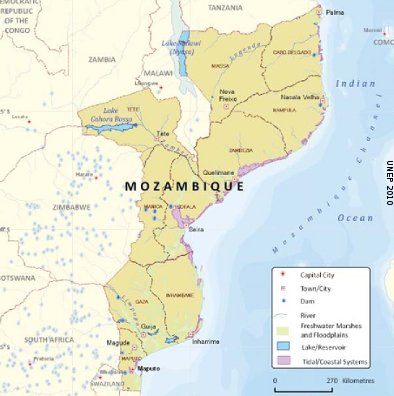However, given its geographic location, Mozambique is a highly vulnerable to natural disaster, in particular those of a hydro-meteorological nature (floods, drought and cyclones). Diverse climatic conditions, corresponding to the country’s varied topology, mean that national trends are likely to mask considerable variation at the sub-national level.
To demonstrate the human implications of extreme events, according to the IPCC, the floods in 2000/1 affected 2.5 million people, and triggered a US$167 million emergency relief campaign This claimed human lives, caused considerable damage to infrastructure, property and livelihoods, and reduced national growth from roughly 8 to 2%. Vulnerability to floods has increased in peri-urban areas in Mozambique, where during the last three decades unplanned human settlements have been proliferating, gradually expanding to lowlands and marshy areas with high flood risks.
Climate change and its consequences in Mozambique
As the agricultural sector is mainly rain-fed, subsistence production and food security is extremely vulnerable to climate variability and change. Climate change will affect food security by reducing livelihood productivity and opportunities. Erratic weather will undermine rain-fed agricultural systems; heat stress on crops will reduce yields; rising rates of evapo-transpiration will increase pressure on water supplies.
According to UNEP, the availability of freshwater in Mozambique is expected to decrease by over half from 1990 levels by 2025. Although water scarcity is unlikely to occur, water stress will become an increasing problem. In addition to these changes, rising temperatures will also reduce soil moisture, lower water table levels and slow aquifer recharge rates, which will place even further pressure on increasingly scarce water resources.
Plans of action
The Ministry for Co-ordination of Environmental Affairs (MICOA) is the focal point for the government’s climate change response. It is currently in the process of developing a National Adaptation Programme of Action (NAPA), which seeks to priorities projects contributing to the national adaptation effort.
Mozambique has also developed climate change Plan of Action called National Adaptation Plan of Action to Climate Change (NAPA) Programa de Acção Nacional para a Adaptação às Mudanças Climáticas (approved in 2007). The Plan of Action identifies the country’s more urgent needs with regard to climate change through a participative assessment process. Its overall purpose is to improve the country’s capacity to deal with the effects of climate change.
More specifically, the Plan of Action pursues four objectives, as follows:
- strengthening the warning system for natural disaster prevention;
- capacity-building and awareness-raising for farmers to deal with the effects of climate change;
- reducing these effects in coastal areas;
- improving water resources management.
WACDEP implementation
WACDEP focus can be to build the capacity of the institutions and the communities that are involved in the implementation of Plan of Action. There is also a study by the Economics of Adaptation to Climate Change study (EACC) which complement Mozambique’s National Institute for Disaster Management (INGC) which provide a costing of adaptation measures; which incidentally is crucial, and this can help WACDEP to identify are areas that need intervention and provide adequate support to assist Mozambique.
